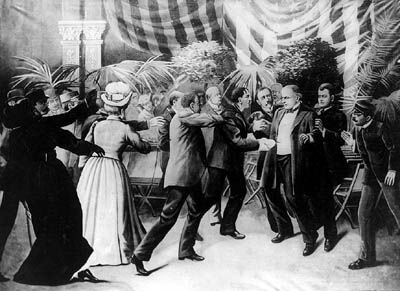
.ref: [American Memory Collection]
A. Big Ben Parker and President McKinley's Assassination
When U.S. President McKinley was assassinated at the Pan American Exposition, as it was first rumored a Negro was involved, Blacks all over the U.S. held their breath until certain it was not a Negro at fault. This is the story.
William McKinley liked world fairs. They were, he said, "the timekeepers of progress. They record the world's advancement." He had been to the Columbian Exposition in Chicago in 1893 and the Cotton States Exposition in Atlanta two years later. He did not want to miss the Pan American Exposition, to be held in Buffalo during the summer of 1901.
On September 6, President McKinley awoke early as was his custom. At 7:15 A.M., fully dressed for the day in his habitual black frock coat and black silk hat, he eluded the small Secret Service entourage that surrounded the Milburn house and took a solitary walk down Delaware Avenue. Later that morning, accompanied by a host of city and exposition officials, the McKinleys boarded a train for Niagara Falls. They visited the falls, walked along the gorge, and toured the Niagara Falls Power Project, which the President referred to as "the marvel of the Electrical Age." After lunch the presidential party returned to Buffalo. Mrs. McKinley went to the Milburn house to rest, and the president to the exposition, where he was scheduled to meet the thousands of people who, in spite of the oppressive heat, were waiting at the Temple of Music, a large, vaguely Byzantine structure on the north side of the fairgrounds.
James Benjamin Parker, A Black Hero
No one had stayed in line longer than "Big Ben" James Parker, a six-foot six inch Negro waiter from Atlanta who was laid-off by the exposition's Plaza Restaurant. Parker had been standing outside the temple since mid-morning in order to get into where the president was to appear. Finally, at 4:00 P.M. the doors of the Temple of Music opened and hundreds of people made an orderly, single-file procession to the front of the auditorium where President McKinley, flanked by John Milburn and his personal secretary, George Cortelyou, stood waiting. It was extremely hot in the room -- over ninety degrees -- and everybody was carrying handkerchiefs, either wiping their brows or waving them at the president. Anarchist Leon Czolgosz had wrapped his right hand in a handkerchief like a bandage and held it as if it were in a sling. His revolver was hidden underneath. A short, Italian man with a thick mustache caught the eye of the president's chief of security, Foster, as suspicious. Foster quicky grabbed the man who was shocked, but harmless. He was let go. This incident distracted Foster and the other guards, by the time it was Czolgosz's turn to shake the President's hand. But Big Ben Parker was in line behind Czolgosz.
As the fast-moving line brought him directly in front of the president, Czolgosz shot twice. The first bullet knicked off a button on McKinley's vest, the second tore into the President's stomach. The handkerchief burst into flames, falling to the floor.
A secret service man's initial eyewitness acount:
"Parker struck the assassin in the neck with one hand and with the other reached for the revolver which had been discharged through the handkerchief and the shots had set fire to the linen.While on the floor Czolgosz again tried to discharge the revolver but before he got to the president the Negro knocked it from his hand."
While Czolgosz was pounced on and beaten by the attending soldiers and guards, McKinley, amid the screeching pandemonium in the room, was carried out and several minutes later was being rushed in an electrical ambulance to the exposition hospital.

.ref: [American
Memory Collection]
Parker clearly prevented Czologoz from firing
a third time. However, it was poor medical technique not bullet
which uptimately caused McKinley's death. The wound was closed
without disinfecting, even standard at that time, so McKinley
died September 14 of gangrene.
ref: The
True Story of the Assassination
ref: Aftermath
of McKinley Assassination
McKinley died on September 14, 1901. Czolgosz was electrocuted on October 29, 1901 and "someone" then poured sulphuric acid on his face, while Czolgosz lay in his coffin, prior to a hasty burial. After Czolgosz killed McKinley, there was a crack-down on anarchists. But what happened to Parker? more at What happened to Parker?